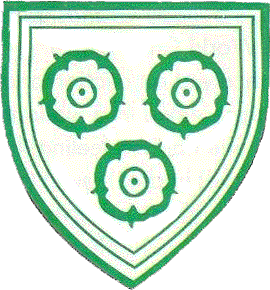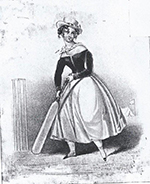Umpiring and Scoring in the Women's Cricket Association: 1926 - 1998
Only eight years after formation in 1926, a WCA team went to Australia and New Zealand. However, then (and for the rest of the WCA lifetime) the home side provided umpires, so this was an Australasian responsibility. The three Tests against Australia and one against New Zealand, three England victories and one Draw, were all umpired by men. This set the scene for all tours abroad. The umpires have always been men. By contrast, when England hosted its first home tour in 1937 the umpires were Misses M.Bryant, K.Doman, P.Drake, F.Hardcastle and C.A.Partridge. This tradition of women's home Tests and, later, ODIs being umpired by women continued right up to 1996.
As there were no formal qualifications on offer, it is not clear how the early pioneers learnt their trade. That they did so is evidenced by a comment from one top level player "If Liz (Riley) gives you out, you know you are out." In 1953 the Association of Cricket Umpires (later to add 'and Scorers' to its title.) was formed with a handful of members, with the aim of lifting the standard of umpiring, particularly at club level, by training and examination. The Association grew rapidly. Before the end of that decade women appeared on the scene. The first woman to qualify was Doris Coysh, a former top level player, with Netta Rheinberg soon after. Others quickly followed. At the meeting prior to the World Cup Tournament in 1973, it emerged that besides England, only Ireland had women with such qualification, despite ACU&S by that time operating in all major cricketing countries. The WCA Yearbook contained lists of umpires and scorers 'approved by the Umpires and Scorers Subcommittee' on the basis of recommendation by their County Association. For umpires, umpiring a number of county matches was also a requirement. Both lists always contained a substantial number of names. Later the lists began to indicate which of the names had full ACU&S qualifications. In 1965 the umpires' list was split, causing some controversy, into two lists A and B. To be on the A list, you had to be recommended by the relevant Territorial Association and be willing to travel to Territorial matches - which might be a very long way.
The Umpires and Scorers Sub-Committee was set up by the Association in 19##. Its remit was threefold:
1.
To maintain the registers. This entailed not only canvassing and assessing the Counties' recommendations, but keeping an ear to the grapevine for feedback from players. Largely because the Association was small so that 'everybody knew everybodyr the lack of formal assessment of umpires was not a problem. This feedback was enough to identify 'horses for courses'. In 1973, World Cup year, there were 14 on the A Register of whom 10 were qualified, 6 on the B Register, one of whom was qualified and 35 on the Scorers. register. The number of umpires on the list changed little but the proportion of qualified umpires increased. In 1991 only one umpire on the A list was not qualified, but only because geographical constraints and work commitments made it difficult for her to attend a course and sit the examinations. She was a good umpire. Scorer's qualifications were not indicated until later, but in any case were less significant, as many excellent scorers did not feel the need to take the examinations.
In due course a number of men appeared on the registers. They were real stalwarts as well as good umpires. They cheerfully accepted not only the policy that, although they were welcome at higher level matches, Tests and ODIs were umpired only by women, but also its concomitant insult of placement on the B register in spite of being fully qualified and very good umpires. In the end, the policy was relaxed and the 1996 Tour by New Zealand saw the two most prominent and long serving of this faithful band, Alan Fox and John Hayes each appointed to a Test match.
2.
To appoint umpires and scorers to higher level matches. These included Territorial (North, South, East, West and Midlands) matches and national competitions, as well as Tests if there was a home tour. National competitions increased in number, with a consequent need for more umpires and scorers. A particular annual headache was the Area Tournament. 12 umpires a day for 5 consecutive days was no simple matter. We sometimes had to be helped out by local chaps. In return we could offer the opportunity for them to stand with our fully qualified women umpires who could comment on their field performance . a requirement for the final stages of qualification. As competitions proliferated, the task of finding umpires and scorers increased. A career development system obtained. A first appointment might be to a Junior Tournament and, as feedback warranted, upward progression made to higher levels, to the Area Tournament and perhaps to the pinnacle of a Test match.
3.
To write the Rules for those same matches. For tours of course, both home and away tours had to be included, and the Rules had to be negotiated between the two countries. This last was not always plain sailing! For a home tour, when agreement on the Rules had been achieved, separate guidance notes on these Rules were issued for Match Organisers, for Captains, for umpires and for scorers. Sometimes the agreed Rules included complicated systems for reducing overs in the event of rain. Then .ready-reckoners. were also issued to umpires. Also, for a home tour, the Umpires & Scorers Sub-Committee organised and ran a one day pre-tour conference for umpires and scorers.
Domestic competitions were legion. Accumulated over the years, there are on file Rules for 25 different competitions. Some, such as a single wicket competition and a senior outdoor 6-a-side competition are no longer extant, but many are. An up-to-date version was issued every year for each competition running that year. When appropriate, special score sheets were produced. For example, in an indoor 6-a-side, not only did runs accrue in strange ways, but batsmen had to retire when they had scored 25, but could return (in order of retirement), when all other wickets had fallen. A special score sheet was a must. We were always sympathetic to the cris-de coeur of the players. As grounds have always been difficult to get, re-arrangement of matches is virtually impossible, so washed out matches could not be replaced. If a match is rained off between a strong team well placed in the League and a team near the bottom, simply to split the points evenly between them is not fair. In a rain affected match, it is not fair to award batting points for scoring a particular number of runs, or bowling points for a simple aggregate of wickets, when a reasonable number of either is not attainable simply because the number of overs has to be markedly cut down. If bowlers are restricted, and two bowlers in the first side bowl the maximum or near maximum and then after rain all are cut down to a much smaller ration, the first side has its bowling attack dominated by those two bowlers and can 'hide' its weaker ones, whereas the second side has to spread bowling more evenly. These were the sort of problems we tackled in our Rules.
Two more things need saying. The first is that until Jack Hayward sponsored the World Cup in 1973, umpires and scorers could not even claim expenses, let alone receive any remuneration. You had not only to pay all your travel costs, find and pay for accommodation if necessary (it always was for top matches), you had to pay for your meals at the ground. The players were in the same boat. Umpiring a Test Match was an expensive business! After 1973, there began to be more sponsorship and gradually money became available for officials, rarely the full amount. Even then some would waive all or part of what they were offered.
The other is that some mention should be made of umpiring and scoring at lower levels. It has always been of a variable standard, but on the whole satisfactory. It is probably worse today than it used to be. Once upon a time most established clubs could boast a qualified or part qualified member or associate who 'did' their matches. Bias existed, but was rare. For a period of some years, one West London club had three fully qualified (women) umpire members. This luxury has largely disappeared, though a few teams are still lucky in this respect. Most women's teams have to compete for the services of one of the totally inadequate stock of umpires available for all non-professional cricket. They are no more and no less successful than men's teams in this. Often only the highest divisions of the Leagues have 'proper' umpires. Scoring was nearly always very competent, except sometimes in the humbler club matches. The biggest complaints in league competitions nowadays are about the difficulty of getting umpires and the frequently poor quality of umpiring. Clubs, male and female, need to persuade members and attached well-wishers to take a course and learn this essential skill, even to a modest level of competence. For the most part, scoring continues to be good.










.jpg)
